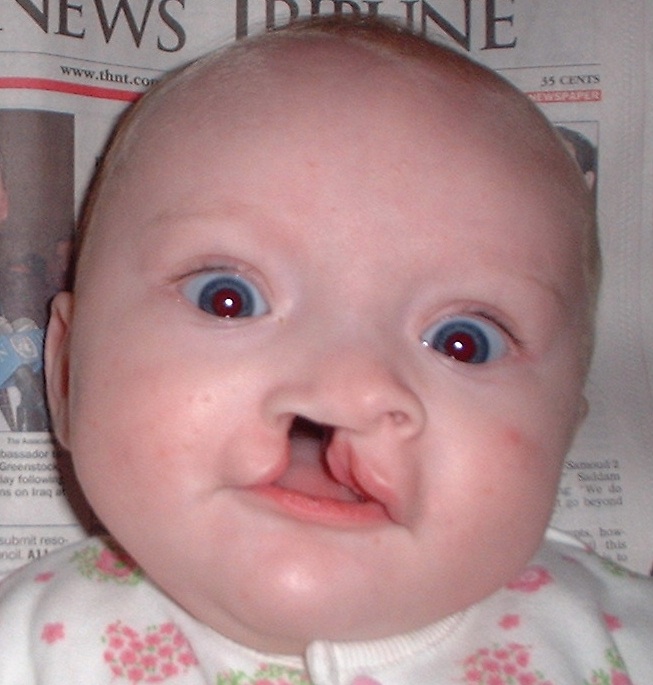Cleft Lip: Symptoms, Causes & Treatment
What are the symptoms of cleft lip?
Cleft lip is a congenital condition characterized by a split or opening in the upper lip. The severity of the cleft lip can vary, ranging from a small notch in the lip to a large opening that extends into the nose. Some common symptoms of cleft lip may include:
- Visible split or opening in the upper lip: The most obvious symptom of cleft lip is a visible split or opening in the upper lip. The cleft may be unilateral (affecting one side of the lip) or bilateral (affecting both sides).
- Nasal deformities: In some cases, cleft lip may be associated with deformities in the nose, such as a flattened or widened nasal bridge, asymmetry of the nostrils, or deviation of the nasal septum.
- Difficulty feeding: Infants with cleft lip may have difficulty feeding, as the cleft can interfere with their ability to create a proper seal around the nipple.
- Speech problems: Cleft lip can also affect speech development, leading to speech problems such as difficulty pronouncing certain sounds.
- Dental problems: Individuals with cleft lip may be at an increased risk of dental problems, such as misalignment of the teeth or missing teeth.
- Ear infections: Children with cleft lip may be more prone to ear infections, which can lead to hearing problems if left untreated.
It’s important to note that cleft lip is a treatable condition, and most children with cleft lip can undergo surgery to repair the cleft and improve their appearance and function. Early intervention and ongoing care by a multidisciplinary team of healthcare providers are important for children with cleft lip to ensure optimal outcomes.
What are the causes of cleft lip?
Cleft lip is a congenital condition, which means it is present at birth. The exact cause of cleft lip is not always known, but it is believed to be the result of a combination of genetic and environmental factors. Some factors that may contribute to the development of cleft lip include:
- Genetics: Cleft lip can run in families, suggesting a genetic component to the condition. However, cleft lip is usually not caused by a single gene, but rather by a combination of genetic factors.
- Environmental factors: Exposure to certain environmental factors during pregnancy may increase the risk of cleft lip. These factors may include maternal smoking, alcohol consumption, certain medications, and infections such as rubella (German measles).
- Nutritional factors: Poor nutrition during pregnancy, particularly a lack of folic acid, may increase the risk of cleft lip.
- Other factors: Some studies suggest that maternal obesity, diabetes, and age may also be risk factors for cleft lip.
It’s important to note that while these factors may increase the risk of cleft lip, not all children born to mothers with these risk factors will have the condition. In many cases, the exact cause of cleft lip is unknown, and it is likely due to a combination of genetic and environmental factors. More research is needed to fully understand the causes of cleft lip and identify ways to prevent it.
What is the treatment for cleft lip?
The primary treatment for cleft lip is surgery to repair the cleft and restore a more normal appearance and function to the lip. The timing of the surgery and the specific approach used may vary depending on the severity of the cleft and the individual’s overall health. In general, surgery to repair a cleft lip is typically done when the child is between 3 and 6 months old.
During the surgery, the surgeon will close the cleft in the lip and may also reshape the nose to improve its appearance. Additional surgeries may be needed as the child grows to further refine the appearance of the lip and nose and improve function.
In addition to surgery, children with cleft lip may benefit from other treatments and therapies, such as:
- Feeding support: Infants with cleft lip may have difficulty feeding, so specialized bottles or nipples may be used to help them feed more effectively.
- Speech therapy: Cleft lip can affect speech development, so speech therapy may be recommended to help improve speech and language skills.
- Dental care: Children with cleft lip may be at an increased risk of dental problems, so regular dental check-ups and treatments may be needed.
- Psychological support: Coping with a visible difference like cleft lip can be challenging, so psychological support may be beneficial for children and their families.
The goal of treatment for cleft lip is to improve the child’s appearance and function and to help them lead a healthy, happy life. A multidisciplinary team of healthcare providers, including surgeons, pediatricians, dentists, speech therapists, and psychologists, is often involved in the care of children with cleft lip to provide comprehensive, coordinated care.




